The Sub-Duct Green Flash
Introduction
When the observer is just below a
duct ,
a very large, long-lasting green flash is visible.
They are the most spectacular of all direct green flashes.
This page shows what they look like, and how they're formed.
As sub-duct flashes are a little more complicated than the flashes due to the
better-known inferior and mock mirages, a little more explanation is
required. That means this page will be a bit more technical than the ones
dealing with those other flashes.

Let's begin with the model. To show the features of this flash well, I've
used a temperature inversion of some 15 degrees. That's a lot, but it's
typical of the strongest inversions formed off the California coast during
Santa Ana conditions, when hot air at 35 or even 40°C flows out over
the ocean, where the water temperature is only 20 or 25°C. Usually,
this temperature difference is split among several weaker inversions; but
on rare occasions, we get the whole difference across a relatively thin layer.
As the one sub-duct flash I've seen was from a height of about 100 m, I've
put the model inversion well above that, with its base at 200 m, and its
top at 250 m height. Those numbers were chosen rather arbitrarily; they
put the base of the duct a little above 130 m, which is 70 m
below the base of the inversion . That's a little higher
than where I was standing; but that difference only makes a little more of
the sunset visible below the
astronomical
horizon :
the
dip
of the sea horizon is about 20 minutes of arc, instead of the 16 or
17′ that I usually see from 100 m.
You can see from the figure how oversimplified this is. Above the
inversion, the profile is just the
Standard Atmosphere;
below it, the
standard lapse rate of 6.5°/km is used. That's not very realistic;
but it's enough to capture the main features of sub-duct flashes.
The corners of the profile have been
smoothed
to capture features that appear when the eye is just at the edge of the
duct. Remember that the local
zenith distance
of a ray is the same at the
top and bottom of a duct; so when the observer is at the bottom, the line
of sight at the astronomical horizon becomes tangent to the upper edge of
the duct, at the top of the inversion.
Before we leave the profile, notice how far the bottom of the duct
is (at about 133 m; not drawn on the figure) below the bottom of the
inversion (at 200 m).
The observer is in a region of perfectly ordinary lapse rate; there's
no hint in the local temperature gradient of the duct immediately overhead.
Transfer curves
You can see where the bottom of the duct is at different wavelengths by
looking at the transfer curves
for a few heights just above 130 m.
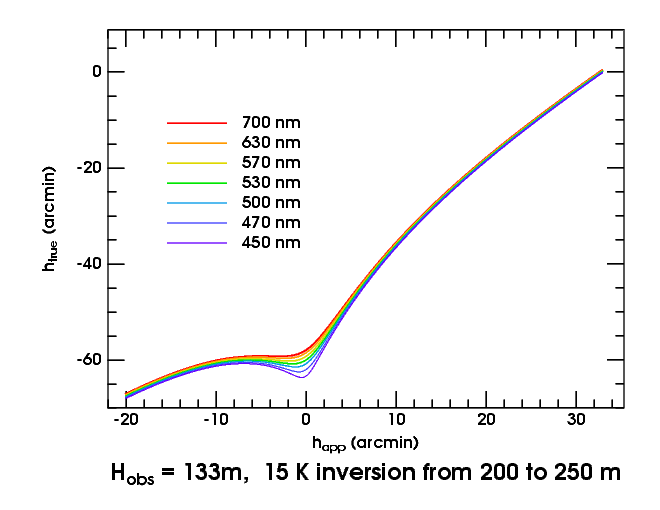
First, here are transfer curves for an observer at 133 m. You can see
we're below the duct at every wavelength here. And the broad minima show
that a large green flash will be visible.
Notice that the minima fall very nearly at the astronomical horizon (the
zero-point on the scale of apparent altitude, at the bottom of the
figure).
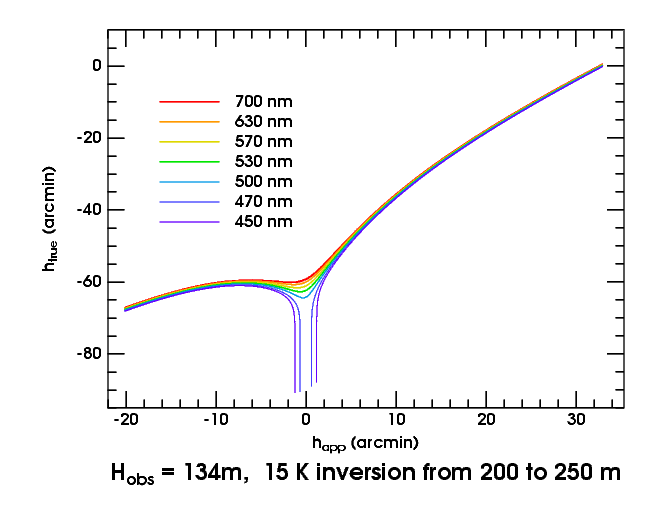
Just a meter higher, we see that we're in the duct at the shortest
wavelengths, but not in green light: the blue and violet curves become
vertical, marking the edges of Wegener's
blank strip.
(Note that the blank strip is symmetrical about the astronomical horizon.)
The greater depth of the green and cyan minima mean that the flash will
last longer here than at 133 m. (Remember that the vertical coordinate of
the transfer curve is true altitude, which is nearly a linear
function of time at sunset.)
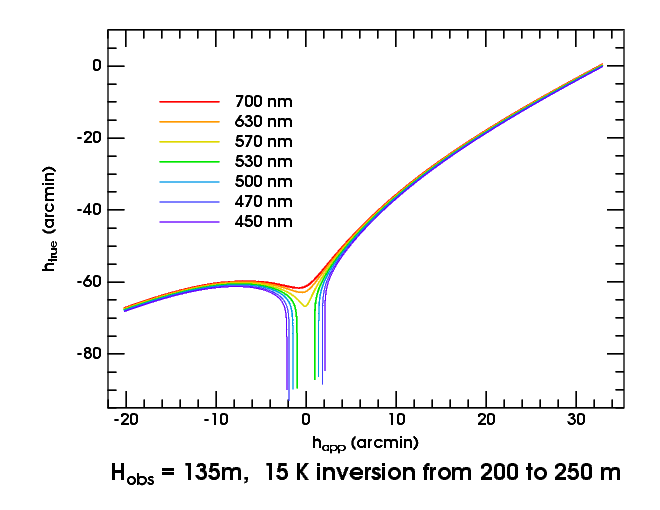
Another meter higher, at 135 m, we're in the duct at green, but not at
the longest wavelengths (red, orange, and yellow). We can have a yellow
or orange flash, but not a green one.
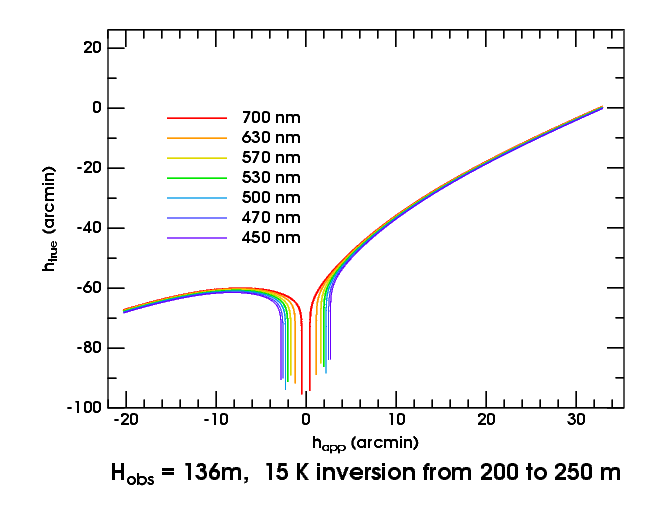
Finally, at 136 m, we're in the duct at all visible wavelengths.
But the width of the blank strip varies greatly with wavelength: it's wide
in the blue, and narrow in red light.
These circumstances produce some peculiar appearances, but not a green
flash.
What a remarkable change in just 3 meters (10 feet) of vertical
distance! What you see at the base of a duct is very sensitive to your
height. And this is for a pretty big duct, too; with a smaller one, these
changes would span an even smaller interval of height.
Now, let's move on to the actual sunset images, below. There's the usual
problem with dynamic range: the computer monitor can't show the range of
brightness in a typical sunset image. So I'll put in a lot of low-lying
aerosol to suppress the brighter parts of the Sun's disk below the flash.
That may make the extinction so big at the sea horizon that you can't
actually see the horizon line.
This is a little artificial, but only a little; some
real sunsets
look like that, too.
You can see from
the transfer curves that the interesting flashes are confined to the
region around 133 or 134 meters above sea level.
Perhaps the best example is the view from 133 m, so we'll start there.
The sub-duct sunset seen at 133 meters
It's worth going through the whole sunset here, not only because there are
interesting phenomena, but also because there are precursors that can
alert you to the imminent appearance of the great sub-duct green flash.

Here's the first indication that something unusual is about to happen.
The Sun's center is 40′ below the true horizon, but none of it
appears below the astronomical one yet. The refraction is clearly larger than
normal; and the most obvious sign of that is the unusually large
flattening of the disk.
Also, if you look closely, you'll see that the red rim on the lower limb
is much wider than usual.
By the way, the little white ticks at the left and right sides of the
figure (just below the lower limb here) mark the astronomical horizon.
I've left in the full amount of sky between it and the apparent horizon,
which is 50 pixels up from the bottom of the image, to emphasize how
high in the sky the features of this sunset appear.

About 20 seconds of time later, the Sun's center is at −44′,
and a big, bulbous red flash has sprouted from the lower limb. →
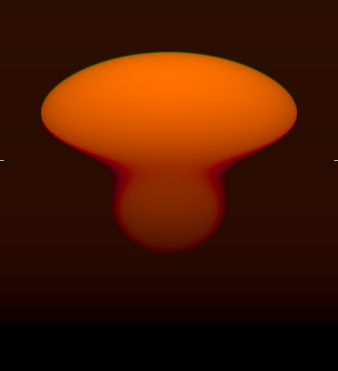
← Four or five seconds later, the Sun is a minute of arc lower, and
the bulb has grown rapidly. This big red flash is the first really striking
feature of this sunset.
Notice that the neck between the flattened upper part and the bulbous
lower part is almost exactly at the astronomical horizon (tick marks).

At −59′, the sides are almost vertical. →
The lower limb fades out into the haze at the apparent horizon, here.

← At −70′, we start to see some green around the edges of the
upper limb. The Sun is now 20′ lower than the depression used to
calculate
nominal sunset times
in the Astronomical Almanac, but we still
see a considerable arc of the strongly-flattened upper limb
above the astronomical horizon.

At −74′, the green edges are wide enough to be seen with the
naked eye. These are clearly much wider than the usual
green rim. →
The neck now rapidly narrows down, pinching off the part at the
astronomical horizon.
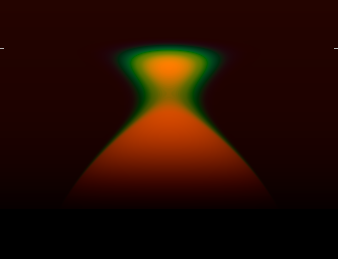
← At −75.5′, the pinching has produced an orange triangle
with a broad green border.
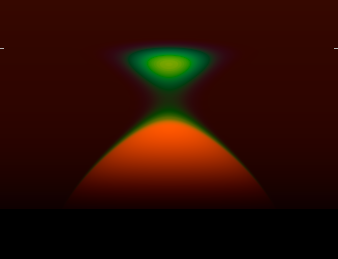
At −76′, the orange has shrunk to nothing, leaving a big green
flash. The triangular shape is very characteristic of the
sub-duct flash. →
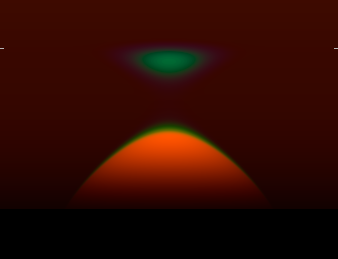
← At −76.5′, the green triangle is shrinking. But it has
already been visible for two seconds (if seen near the equator) or three
seconds (at about 50° latitude) — that's already longer than a
normal green-rim flash, such as an
inferior-mirage flash
or a
mock-mirage flash.
And we still have a way to go.

At −77′, the flash is fading, but still visible — and
it's already been visible for about three times the duration of a normal
flash. Even at this stage, it's larger than the average flash of the
commoner kinds. →
Notice that the flash faded from the bottom up, leaving a green
ellipse at the astronomical horizon.
At this stage, it's easily mistaken for a mock-mirage flash.
But look how much higher in the sky it is than a mock mirage. Once you
see the differences, you can tell them apart.

How long can we follow this slowly fading flash?
← Here's an enhanced
image (in effect, overexposed to show faint details) at
−77.5′. There's still a pale elliptical
wisp visible at the astronomical horizon, if you look closely. This is
bluish in color; it would require extremely clear air to be seen.
Variations with height of eye
The appearance of the sub-duct flash varies rapidly with height of the
eye, as you'd expect from the dramatic changes in the transfer curves with
height. If the observer is too low, the transfer curves have no minimum;
there's an extended green rim, but not a proper flash at all.
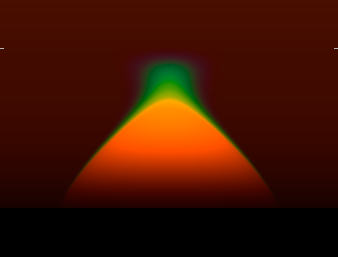
← For example, here's what an observer 131 meters above sea level sees when
the Sun's center is 75′ below the horizontal.
(Colors in the bright orange part of the disk are distorted by clipping
the brightest reds to make the green plainly visible.)
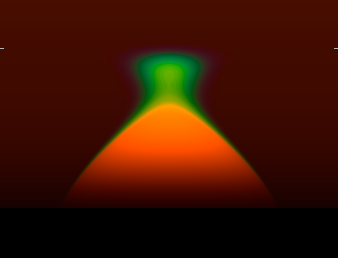
But at 132 m, the eye is close enough to the bottom of the duct to have a
proper green flash. →
Notice that there's a bulge at the top of the green area, even though it
isn't separated from the orange disk below it.
The neck below the bulge is an inverted image of part of the upper limb
— due to a mirage: Wegener's Nachspiegelung .
In this and the following pictures, the “green flash” stage is
arbitrarily chosen to be the moment when the wavelength of 580 nm has
just disappeared from view in the middle of the flash.
That is, we draw a horizontal tangent to the bottom of the dip in the
580-nm transfer curve, and place the Sun's upper limb at that true
altitude.

←
At 133 m, the flash is entirely separated from the orange disk below it,
and triangular in shape. This is very nearly the same as the sub-duct
flash image shown in the main sunset sequence above for a true zenith
distance of −76′. However, this version has been brightened
to show the green area better, while (as mentioned before) losing color
fidelity in the overexposed orange disk. Also, the altitude of the Sun's
center is now −76.0937 minutes instead of −76 exactly, so as
to show the appearance when the last bit of 580-nm light has disappeared.
You can see a faint remnant of the stalk that connected the green flash to
the disk below it in the previous picture; it's the dim green glow
just above the orange disk.
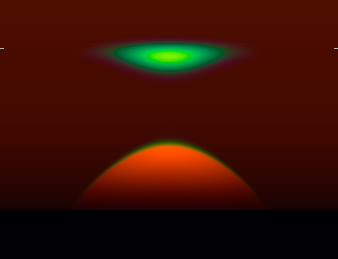
At 134 m, the flash has flattened out; it's wider in the horizontal
direction, but thinner in the vertical. The solar depression is now
77.4134′, which moves the orange disk down into the haze more,
reducing the dynamic-range problem; so the disk colors are only a little
distorted. (The colors in the flash, as in all the above images, are
correct — or, at least, as correct as the
limitations of computer displays
allow.) →
It isn't obvious here, but we're already starting to run into the duct
itself at the shorter wavelengths. That is, there's a narrow blank strip
at blue wavelengths, right at the astronomical horizon. But the blue
light is so attenuated by atmospheric extinction that it contributes next
to nothing to the image, and you don't see anything peculiar at the
astronomical horizon. However, the width of the blank strip is
proportional to the square root of distance above the bottom of the duct;
so just a few centimeters more will suffice to produce an apparent defect
through the middle of the flash.
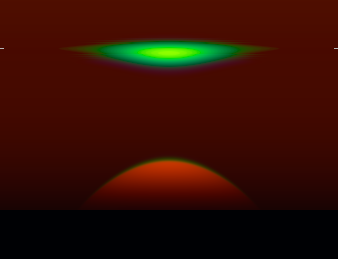
←
So we can't even get a proper flash at 135 meters, because the
transfer curves
become so strange that our rule for picking a green-flash altitude
gives a very odd result. You can see the problem developing here at 134.5
meters, where the Sun's depression is 78.593′ at the flash.
There's still a minimum in the
yellow-green transfer curve; but some of the green is interrupted by a
blank strip, whose width increases as wavelength decreases.
The changes are so rapid with wavelength that we're beginning to have
visible artifacts due to the limitations of my
method
of interpolating between tabulated refraction data.
Of course the trend toward flatter flashes with increasing height of
the eye has continued. We now have a flash whose width, left to right, is
about 3/4 the diameter of the Sun. Because the orange disk is now deep in
the haze at the horizon, the dynamic-range problem has disappeared: the
relative brightnesses and colors in this image have not been adjusted.
Beyond this point, the effects of the duct edge are so strong that I can't
generate satisfactory simulations. I'll have to give up here, for the
time being.
Discussion
The sub-duct flash can certainly be huge. If the duct and the observer
were moved down about 120 meters, the orange disk would lie completely
below the sea horizon when the sub-duct flash appears. Then it would seem
that the whole Sun had turned green; and, with no orange light available
to light up the boundary-layer aerosol, we'd probably have enough green
illumination to make green crepuscular rays in the aureole of the flash.
I suspect that's how the various kinds of
“green ray”
displays are produced.
A sunset of that type has actually been photographed by Mila Zinkova,
and a video of it is
available
on YouTube. But, unfortunately, the extinction was so large that what
should have been a spectacular big green flash at the end was reduced to a
dim, red inverted image of the upper limb, as a shrinking, nearly-circular
blob. She says that the camera was only 23 feet above sea level —
which accounts for the lack of the lower image shown in the simulations
above. (The geometry of her sunset was also modified by the presence of
two strong inversions, not just one.)
Such sunsets are very rare; I have seen only one myself.
Copyright © 2005 – 2012, 2013, 2016, 2023 Andrew T. Young
Back to the ...
main simulation page
or the
transfer-curve page
or the
GF home page




















